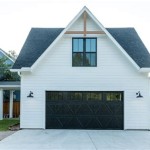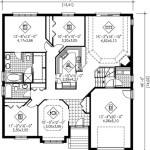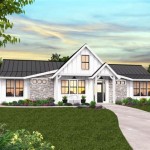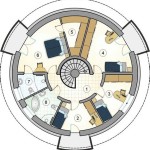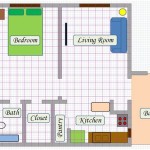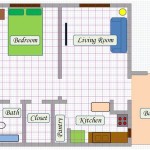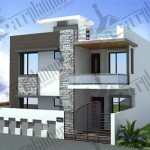Understanding 2-Bedroom Bungalow House Plans
The 2-bedroom bungalow house plan represents a significant portion of residential construction, offering an optimal balance of affordability, space efficiency, and accessibility. This design caters to various demographics, from young couples and small families to retirees seeking manageable living spaces. Its popularity stems from its adaptability and the ease with which it can be tailored to fit specific needs and aesthetic preferences.
A bungalow, historically speaking, is characterized by its low-profile design, typically featuring a wide, covered porch and a single story or a story-and-a-half configuration. This architectural style emphasizes horizontal lines and a seamless connection between indoor and outdoor living areas. The modern interpretation of the bungalow often incorporates contemporary design elements while retaining the core principles of accessibility and functional layout.
Choosing the right 2-bedroom bungalow house plan requires careful consideration of several factors, including lot size and orientation, local building codes, lifestyle requirements, and budget constraints. A well-designed plan maximizes the available space, minimizes construction costs, and creates a comfortable and inviting living environment.
Benefits of Choosing a 2-Bedroom Bungalow
One of the primary advantages of a 2-bedroom bungalow is its affordability. With a smaller footprint compared to larger multi-story houses, the construction costs for materials, labor, and foundation work are significantly reduced. This makes it an attractive option for first-time homebuyers or individuals looking to downsize without sacrificing essential living space.
The single-story design offers unparalleled accessibility, making it ideal for individuals with mobility limitations or those planning to age in place. The absence of stairs eliminates the risk of falls and simplifies daily tasks, such as cleaning and moving furniture. Furthermore, universal design principles can be easily incorporated into the bungalow layout to enhance accessibility for individuals with disabilities.
Bungalows are inherently energy-efficient due to their compact design and minimal exterior wall surface area. This reduces heat loss in colder climates and heat gain in warmer climates, resulting in lower energy bills and a smaller carbon footprint. Strategic placement of windows and doors can further enhance natural ventilation and minimize the need for artificial lighting.
Finally, 2-bedroom bungalows offer a sense of privacy and tranquility. Typically situated in residential neighborhoods with ample green space, these homes provide a peaceful retreat from the hustle and bustle of urban life. The low-profile design blends seamlessly with the surrounding landscape, creating a harmonious living environment.
Key Design Considerations for 2-Bedroom Bungalow House Plans
Effective space planning is crucial in a 2-bedroom bungalow. Given the limited square footage, every inch must be utilized efficiently. Open-concept floor plans are a popular choice, creating a sense of spaciousness by combining the living room, dining area, and kitchen into a single, flowing space. This design also facilitates social interaction and allows for better natural light distribution.
Room sizes should be carefully considered to accommodate furniture and daily activities comfortably. The master bedroom should typically be larger than the second bedroom, providing ample space for a king-size bed, dressers, and a walk-in closet. The second bedroom can serve as a guest room, home office, or children's room, depending on the homeowner's needs.
The kitchen layout should be functional and ergonomic, with a well-defined work triangle between the sink, stove, and refrigerator. Ample counter space and storage are essential for food preparation and organization. Consider incorporating a breakfast bar or island to add extra seating and workspace.
Bathroom design should prioritize accessibility and comfort. A walk-in shower or a curbless shower enclosure is a practical choice for individuals with mobility limitations. Consider installing grab bars and a comfort-height toilet to enhance safety and convenience. Sufficient ventilation is crucial to prevent moisture buildup and mold growth.
Outdoor living spaces are an integral part of the bungalow lifestyle. A covered porch or patio provides a sheltered area for relaxation and entertaining. Consider adding landscaping elements, such as trees, shrubs, and flowers, to create a visually appealing and inviting outdoor environment. A small garden or vegetable patch can add to the charm and functionality of the outdoor space.
Exploring Different Styles of 2-Bedroom Bungalow House Plans
The Craftsman bungalow is a classic style characterized by its emphasis on handcrafted details and natural materials. Features typically include exposed rafters, decorative brackets, and a wide, covered porch supported by tapered columns. The interior often features wood trim, built-in cabinetry, and a fireplace as a focal point.
The Contemporary bungalow incorporates modern design elements, such as clean lines, large windows, and open floor plans. This style often features a minimalist aesthetic with neutral color palettes and sleek finishes. Energy-efficient features, such as solar panels and rainwater harvesting systems, are commonly integrated into the design.
The Ranch bungalow is a sprawling, single-story design with a low-pitched roof and horizontal emphasis. This style is well-suited for larger lots and often includes a attached garage and a spacious backyard. Ranch bungalows are known for their ease of maintenance and accessibility.
The Cottage bungalow evokes a sense of charm and coziness with its quaint details and rustic materials. Features typically include dormer windows, a gabled roof, and a covered porch with decorative railings. The interior often features exposed beams, hardwood floors, and a fireplace.
Beyond these common styles, various regional variations exist, each reflecting local architectural traditions and climate considerations. For example, Florida bungalows often feature stucco exteriors and large windows to maximize natural light, while California bungalows may incorporate elements of Spanish Colonial architecture.
The choice of style ultimately depends on the homeowner's personal preferences and the surrounding environment. It's important to select a style that complements the existing neighborhood and reflects the homeowner's individual taste.
When considering a 2-bedroom bungalow house plan, carefully evaluate various options and prioritize features that align with individual needs and lifestyle. Consulting with an experienced architect or builder can provide valuable insights and ensure that the final design meets all requirements and building codes. By taking a thoughtful and informed approach, homeowners can create a comfortable, functional, and aesthetically pleasing living space that suits them for years to come.

Refreshing Two Bedroom Bungalow House Plan

Small House Design With 2 Bedrooms

2 Bedroom Modular Home Floor Plans Rba Homes

Typical Floor Plan Of The 2 Bedroom Single Family Bungalow Building Scientific Diagram

Peralta 2 Bedroom Bungalow House Design Pinoy Eplans

Bungalow Simple Small 3 Bedroom House Plans Pic Flab 0cf

Bungalow House 2 Bedrms 1 Baths 890 Sq Ft Plan 123 1109

Floor Plan Of Two Bedroom Bungalow Scientific Diagram

Peralta 2 Bedroom Bungalow House Design Engineering Discoveries

Stylish Two Bedroom House Plan

